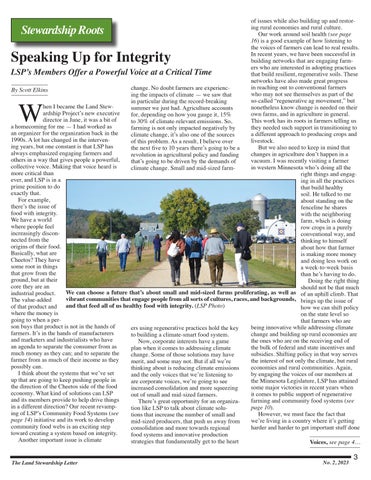of issues while also building up and restoring rural economies and rural culture. Our work around soil health (see page 16) is a good example of how listening to the voices of farmers can lead to real results. In recent years, we have been successful in building networks that are engaging farmers who are interested in adopting practices LSP’s Members Offer a Powerful Voice at a Critical Time that build resilient, regenerative soils. These networks have also made great progress in reaching out to conventional farmers change. No doubt farmers are experiencBy Scott Elkins who may not see themselves as part of the ing the impacts of climate — we saw that so-called “regenerative ag movement,” but in particular during the record-breaking hen I became the Land Stewnonetheless know change is needed on their summer we just had. Agriculture accounts ardship Project’s new executive own farms, and in agriculture in general. for, depending on how you gauge it, 15% director in June, it was a bit of This work has its roots in farmers telling us to 30% of climate-relevant emissions. So, a homecoming for me — I had worked as they needed such support in transitioning to farming is not only impacted negatively by an organizer for the organization back in the a different approach to producing crops and climate change, it’s also one of the sources 1990s. A lot has changed in the intervenlivestock. of this problem. As a result, I believe over ing years, but one constant is that LSP has But we also need to keep in mind that the next five to 10 years there’s going to be a always emphasized engaging farmers and changes in agriculture don’t happen in a revolution in agricultural policy and funding others in a way that gives people a powerful, vacuum. I was recently visiting a farmer that’s going to be driven by the demands of collective voice. Making that voice heard is in western Minnesota who’s doing all the climate change. Small and mid-sized farmmore critical than right things and engagever, and LSP is in a ing in all the practices prime position to do that build healthy exactly that. soil. He talked to me For example, about standing on the there’s the issue of fenceline he shares food with integrity. with the neighboring We have a world farm, which is doing where people feel row crops in a purely increasingly disconconventional way, and nected from the thinking to himself origins of their food. about how that farmer Basically, what are is making more money Cheetos? They have and doing less work on some root in things a week-to-week basis that grow from the than he’s having to do. ground, but at their Doing the right thing core they are an should not be that much We can choose a future that’s about small and mid-sized farms proliferating, as well as of an uphill climb. That industrial product. vibrant communities that engage people from all sorts of cultures, races, and backgrounds, brings up the issue of The value-added of that product and and that feed all of us healthy food with integrity. (LSP Photo) how we can shift policy where the money is on the state level so going to when a perthat farmers who are son buys that product is not in the hands of being innovative while addressing climate ers using regenerative practices hold the key farmers. It’s in the hands of manufacturers change and building up rural economies are to building a climate-smart food system. and marketers and industrialists who have the ones who are on the receiving end of Now, corporate interests have a game an agenda to separate the consumer from as the bulk of federal and state incentives and plan when it comes to addressing climate much money as they can; and to separate the subsidies. Shifting policy in that way serves change. Some of those solutions may have farmer from as much of their income as they the interest of not only the climate, but rural merit, and some may not. But if all we’re possibly can. economies and rural communities. Again, thinking about is reducing climate emissions I think about the systems that we’ve set by engaging the voices of our members at and the only voices that we’re listening to up that are going to keep pushing people in the Minnesota Legislature, LSP has attained are corporate voices, we’re going to see the direction of the Cheetos side of the food some major victories in recent years when increased consolidation and more squeezing economy. What kind of solutions can LSP it comes to public support of regenerative out of small and mid-sized farmers. and its members provide to help drive things farming and community food systems (see There’s great opportunity for an organizain a different direction? Our recent revamppage 10). tion like LSP to talk about climate soluing of LSP’s Community Food Systems (see However, we must face the fact that tions that increase the number of small and page 14) initiative and its work to develop we’re living in a country where it’s getting mid-sized producers, that push us away from community food webs is an exciting step harder and harder to get important stuff done consolidation and more towards regional toward creating a system based on integrity. food systems and innovative production Another important issue is climate strategies that fundamentally get to the heart Voices, see page 4…
Stewardship Roots
Speaking Up for Integrity
W
The Land Stewardship Letter
No. 2, 2023
3

















